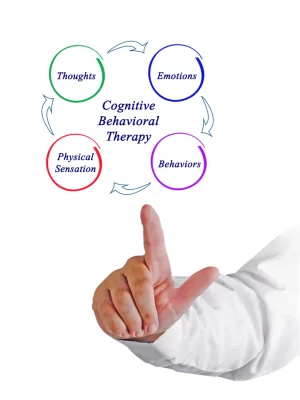

The relationship between mental health and Patellofemoral Pain Syndrome has become a hot topic in the last several years.
This has become a hot topic for two reasons.
First, even when individuals receive evidence based Patellofemoral Pain Syndrome rehab, 40% to 57% have shown to have poor outcomes [1].
That is, Patellofemoral Pain Syndrome has shown to persist in A LOT of people!
This is where the second reason on why mental health and Patellofemoral Pain Syndrome has become a hot topic comes into play.
It has been found that some individuals with Patellofemoral Pain Syndrome demonstrate increased anxiety, depression, or fear-avoidance behaviors [1] [2] [3] [4]. This is thought to be one reason why some individuals have poor outcomes, regardless of the treatment utilized.
So, this article is all about mental health and Patellofemoral Pain Syndrome!
In a 2015 study, 17 Patellofemoral Pain Syndrome experts shared their thoughts on rehabbing this condition.
In this study, to be considered a “Patellofemoral Pain Syndrome expert”, the following criteria was required:
My point is, the experts interviewed in this study know what they are talking about!
When asked about the relationship between mental health and Patellofemoral Pain Syndrome, the experts said [1]:
“Psychological or psychosocial interventions that really, if you’re thinking about someone with chronic Patellofemoral pain, and particularly those young girls who have had it for so long and no matter what you try, it doesn’t work, I think introducing more kind of psychosocial, or a more psychosocial approach, is likely to be beneficial.”
“(There is) a sort of psychological subgroup, that you can look at their biomechanics and their activity patterns until the cows come home, but until you sort out the psychological component of their problem, it isn’t going to make any difference.”
“Sometimes patients are very fearful of even moving and unless this is addressed they just decondition and that makes the problem worse.”
“Particularly in the younger girls I see, they have this fear of movement, this fear of loading up their knee, and so they actually offload so much that they get weaker and therefore more pain.”
I shared this with you because it can be hard to know if the information someone tells you is accurate.
This is especially relevant when reading a blog post. Reading a blog post adds more uncertainty when you likely don’t even know the author.
That being said, I strongly believe there is a relationship between mental health and Patellofemoral Pain Syndrome.
You should know why I believe this too, as this is what the experts think!
There are two reasons why it is important to address the relationship between mental health and Patellofemoral Pain Syndrome.
These two reasons are:
It is well known that anxiety, depression, or fear of moving occur in patients with Patellofemoral Pain Syndrome [1] [2] [3] [4].
Furthermore, it has also been found that those with Patellofemoral Pain Syndrome that have poor mental health, also have higher pain levels [1].
So, in theory, if the relationship between mental health and Patellofemoral Pain Syndrome can be improved, then pain would decrease.
That can’t be that hard, right?
Not so quick.

The mechanism by how mental health can influence pain is an extremely complex process.
Furthermore, more than one theory has been proposed. This goes to show not only how complex this process is, but also highlights the fact more research is necessary.
Although multiple theories have been proposed, it is fairly agreed upon and backed by evidence that mental health can influence the behavior of the brain. As a result, this can increase pain.
The relationship between mental health and Patellofemoral Pain Syndrome can also influence a patient’s outcomes.
As the relationship between mental health and Patellofemoral Pain Syndrome is fairly new, there is not an abundance of evidence showing that poor mental health can cause poor outcomes.
That being said, evidence is beginning to emerge demonstrating improved outcomes when mental health is addressed in those with Patellofemoral Pain Syndrome.
For example, a 2014 study showed that reductions in anxiety, depression, and fear of moving resulted in reduced pain and improved function [7].
So in theory, by NOT addressing one’s mental health may lead to poor outcomes.
Furthermore, the impact of poor mental health has been studied in other conditions, such as low back pain.
Low back pain patients with poor mental health have shown to be less compliant in completing their home exercise program [2].
If a home exercise program was not important for Patellofemoral Pain Syndrome, the comparison to low back pain would not matter. But, that is not the case.
Compliance with a home exercise program is VITAL for recovering from Patellofemoral Pain Syndrome!
As such, it is likely that poor mental health has a negative impact on a patient’s compliance with their Patellofemoral Pain Syndrome rehab.
If you have made it this far in reading this blog, don’t give up now!
I saved the best, for last.
Addressing the relationship between mental health and Patellofemoral Pain Syndrome involves these two steps:
For some patients with Patellofemoral Pain Syndrome, it is obvious when mental health is a factor. For others, it is not so obvious.
In either scenario, utilizing one or more outcome measures can help.
Outcome measures come in various forms, such as self reported questionnaires or tests that a healthcare professional will perform on a patient directly.
In terms of Patellofemoral Pain Syndrome, there are 3 common outcome measures used. These outcome measures can assist in identifying the presence, or lack of, psychological factors in a patient.
The 3 common outcome measures used are [5] [8]:
The first two outcome measures listed above self-reported questionnaires completed by the patient. They are both used to assess how anxiety, depression, or fear of moving influences one’s pain.
To learn more about the Tampa Scale for Kinesophobia, click here.
To learn more about the Fear avoidance Beliefs Questionnaire, click here.
QST is different from the other two outcome measures in that it is an assessment that a healthcare professional completes on a patient directly.
By applying various stimuli to a patient, such as pressure or heat, this assessment tool can help gauge an individual’s pain response.
To learn more about QST, click here.

After completing the assessment step, if any psychological factors are identified, it then comes down to figuring out how to treat them.
There are several treatment strategies that are useful to address those with psychological factors.
The goal of each treatment strategy is to ultimately decrease one’s pain and improve their function, while reducing the influence of any psychological factors.
Some common treatment strategies include [6] [8] [9] [10]:
If this article applies to you thus far, I highly advise you to work with a healthcare professional that is knowledgeable in pain science.
I am saying this because, although surprising, not every healthcare professional is knowledgeable in pain science. This is due to the fact that pain science is not only continually evolving, but it is also extremely complex.
To put it another way, if you are working with someone unfamiliar with pain science, they may get you to believe your pain is just in your head and is not real.
THIS COULD NOT BE FARTHER FROM THE TRUTH. Your pain is REAL and it is produced by the brain.
Yes, the mechanisms of how pain presents is complex. But, it can be helpful to know why you are feeling the way that you are.
In some people, by knowing what is causing their pain, their anxiety and fear decrease drastically.
Do you know what sometimes follows decreased anxiety and fear?
Decreased pain levels!
At first glance, CBT sounds like a complex treatment that only a Psychologist knows how to use.
Don’t get me wrong, CBT is in no way simple. Also, there are definitely situations that call for a referral to a Psychologist.
That being said, Physical Therapists can also use CBT to address the relationship between mental health and Patellofemoral Pain Syndrome.

The first step in CBT is identifying the presence of any maladaptive beliefs or behaviors. From there, a variety of CBT strategies are utilized in order to change the maladaptive beliefs or behaviors. By doing so, it is thought that this will result in less pain and improved function.
Some examples of CBT strategies include:
Graded exposure therapy is another strategy that can assist with addressing the relationship between mental health and Patellofemoral Pain Syndrome.
The purpose of graded exposure therapy is to identify what a patient fears with the goal of eventually overcoming those fears. The process of overcoming fear involves gradually exposing a person to what they fear.
In terms of Patellofemoral Pain Syndrome rehab, graded exposure can first be used to identify what movements a patient fears. Then, through various techniques, that movement can slowly be reintroduced to the patient to help with overcoming their fear.
This treatment strategy involves videoing a patient walking or running. From there, the video is reviewed with the patient with a discussion related to the patient’s psychological factors.
Before I say too much, I must say that this is a brand new approach to addressing the relationship between mental health and Patellofemoral Pain Syndrome. As such, more evidence is required to understand the usefulness of this approach.
That being said, the preliminary evidence demonstrates some benefits.
A 2021 study, demonstrated the use of a psychologically informed video significantly reduced pain related fear [10].
By reading this blog, you should now know that the relationship between mental health and Patellofemoral Pain Syndrome is real.
Treatment approaches to address the mental health and Patellofemoral Pain Syndrome relationship has just recently emerged, and is continuing to emerge.
It takes time and energy for Physical Therapists to stay up to date on the latest evidence for every single injury.
In other words, not every Physical Therapist is up to date on the mental health and Patellofemoral Pain Syndrome relationship.
However, assuming you read this entire article, you should now be aware of what to look for in a Physical Therapist.
For those of you that skimmed the article, the take home message is this:
Failing to address an individual’s mental status can lead to poor outcomes.
While on the other hand, addressing it can improve one’s outcomes!
This site uses Akismet to reduce spam. Learn how your comment data is processed.

No Comments